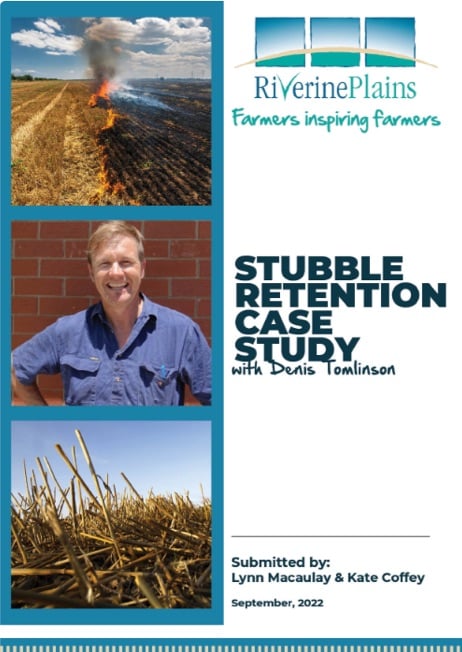Stubble Retention Case Study with Denis Tomlinson

Publication date
22 Nov 2022
Publication partner
This publication was supported by the Foundation for Rural and Regional Renewal.
LEARN HOW FARMERS ARE MANAGING THEIR STUBBLE AND IF IT HAS CHANGED IN THE PAST 5 YEARS
In this case study, Lynn our Member Engagement Officer, caught up with Denis Tomlinson to ask him about his stubble management practices.
Key messages
Strategic and flexible stubble management:
- Stubble management should be adaptable and strategic rather than rigid. Retain stubble where possible, but use tools like mulching or shallow incorporation to optimize farming efficiency. Burning should only be a last resort.
Crop management with retained stubble:
- Longer stubble can delay flowering and maturity, which can be advantageous for spreading sowing operations. It doesn’t significantly increase frost risk, which is more dependent on flowering dates and frost event timing.
Soil health and structure:
- Retaining stubble improves soil structure, increases moisture retention, and reduces time and labor in the paddock.
- Incorporating pulses like faba beans and vetch in crop rotations can enhance soil nitrogen levels, providing a chemical and disease break.
Challenges and solutions:
- High stubble loads may necessitate burning to manage pre-emergent chemical application and improve nitrogen availability. Applying urea early post-emergence can help mitigate nitrogen tie-up.
- Adjust management practices based on weather conditions, such as burning additional paddocks after high summer rainfall to ensure timely sowing.
Technological and practical considerations:
- Accurate GPS systems are essential for inter-row sowing through retained stubble.
- Different sowing methods and equipment affect the thresholds for stubble retention. For example, slashing or cutting stubble to a manageable height can aid in sowing and reduce residue issues.
Benefits of no-till and full stubble retention:
- Improved soil structure and higher moisture conservation, are especially beneficial in dry summer months.
- Retaining stubble in low rainfall years conserves moisture and prevents soil erosion.
Potential drawbacks of stubble retention:
- Some farmers face challenges like poor weed control, perception of increased frost risk, higher pest populations, nitrogen tie-up, and poor crop establishment due to shading.
- Wet summers can exacerbate pest problems in retained stubbles; effective pest management strategies are essential.
Investment and equipment:
- Investing in or hiring equipment like slashers can help manage stubble more effectively. Farmers have increasingly retained more stubble over the past decade.
Ongoing research and knowledge gaps:
- Further research is needed to understand the extent of stubble retention’s impact on soil carbon levels.
- Effective management of higher pest populations due to wet summers is crucial for maintaining productivity.
NEWS
Discover unique perspectives on agriculture from across the Riverine Plains.
-
Livestock
-
People
-
Grains
-
Sustainability

